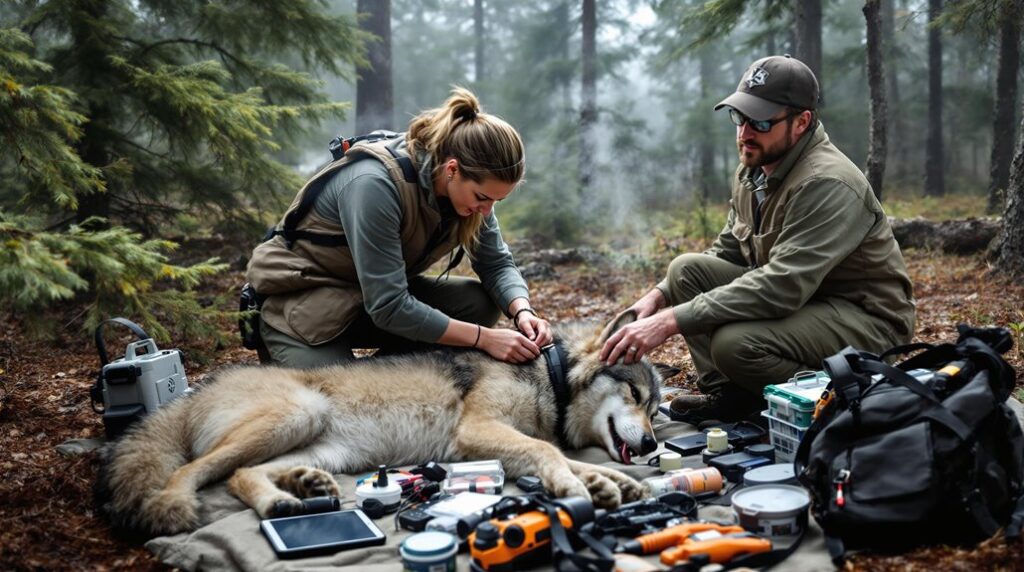If you’re looking to advance your wildlife biology career, you’ll find exceptional graduate programs at several top universities. The University of Florida ranks #1 with a 97% retention rate and strong online options, while the University of Alaska Fairbanks offers unique field experiences and a perfect job placement record. Cornell University provides prestigious research facilities, and Stanford delivers an innovative interdisciplinary approach. You’ll benefit from thorough curricula, research opportunities, and competitive funding options at these institutions. Each program offers distinct advantages that can shape your future in wildlife conservation and research.
Top Wildlife Biology Graduate Programs Comparison
| University | Location | Degree Programs | Research Focus | Notable Features | Average Time to Completion |
|---|---|---|---|---|---|
| University of Montana | Missoula, MT | MS, PhD | Wildlife ecology, conservation biology | Montana Cooperative Wildlife Research Unit, proximity to diverse ecosystems | 2.5 years (MS), 5 years (PhD) |
| Colorado State University | Fort Collins, CO | MS, PhD | Wildlife management, disease ecology | Partnership with federal agencies, strong quantitative focus | 2 years (MS), 4.5 years (PhD) |
| University of Florida | Gainesville, FL | MS, PhD | Tropical ecology, wetland wildlife | Extensive field stations, international research opportunities | 2 years (MS), 5 years (PhD) |
| University of California-Davis | Davis, CA | MS, PhD | Conservation genetics, behavioral ecology | Interdisciplinary approach, extensive lab facilities | 2-3 years (MS), 5-6 years (PhD) |
| Texas A&M University | College Station, TX | MS, PhD | Range management, wildlife-human conflict | Caesar Kleberg Wildlife Research Institute, strong industry connections | 2 years (MS), 4 years (PhD) |
| Cornell University | Ithaca, NY | MS, PhD | Avian ecology, conservation policy | Cornell Lab of Ornithology, extensive funding opportunities | 2 years (MS), 5-6 years (PhD) |
| University of Alaska-Fairbanks | Fairbanks, AK | MS, PhD | Arctic wildlife, large mammal studies | Unique arctic ecosystem access, strong agency partnerships | 3 years (MS), 5-6 years (PhD) |
| University of Wisconsin-Madison | Madison, WI | MS, PhD | Wildlife disease, habitat management | Long-term ecological research sites, interdisciplinary approach | 2-3 years (MS), 5 years (PhD) |
| Oregon State University | Corvallis, OR | MF, MS, PhD | Forest wildlife, marine mammals | H.J. Andrews Experimental Forest, coastal research stations | 2 years (MS), 4-5 years (PhD) |
| Virginia Tech | Blacksburg, VA | MS, PhD | Human dimensions, wildlife management | Conservation Management Institute, strong eastern ecosystem focus | 2 years (MS), 4 years (PhD) |
Top Wildlife Biology Schools
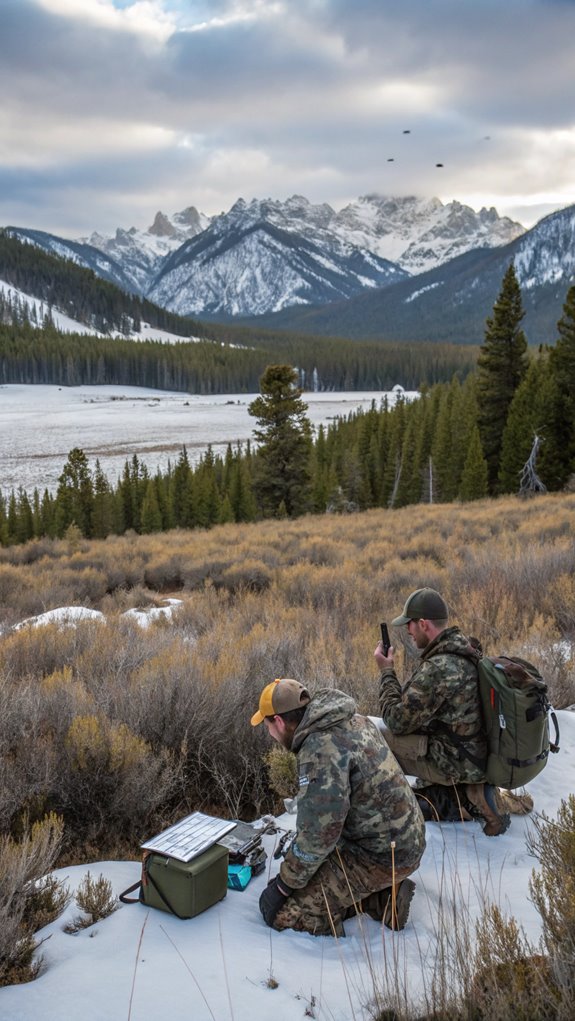
The nation’s top wildlife biology graduate programs offer diverse opportunities for advanced study and research in wildlife conservation, ecology, and management. At the University of Florida, ranked #1 for Wildlife and Wildlands Science, you’ll find a program with a 97% retention rate and extensive field research opportunities. The program’s 46% online enrollment provides flexibility while maintaining rigorous academic standards. Graduate salary prospects show a median annual income of $72,740 in this sector.
If you’re seeking unique field experiences, the University of Alaska Fairbanks stands out with its 30-credit hour program and unparalleled access to diverse ecosystems. The program boasts a 100% placement rate for graduates in field-related positions. The University of Wisconsin-Madison offers detailed research opportunities in wildlife ecology, with a strong 95% retention rate and reasonable tuition costs for both in-state and out-of-state students.
For those targeting prestigious institutions, Cornell University‘s wildlife and fisheries management programs provide access to advanced research facilities and field opportunities. Though highly selective with a 7% acceptance rate, Cornell’s detailed programs justify its competitive admission standards. Stanford University offers an interdisciplinary approach, combining ecology, biology, and environmental science, with excellent career prospects for graduates.
You’ll find these top programs share common strengths: strong research opportunities, experienced faculty, and proven track records in placing graduates. Each institution maintains unique advantages, from Florida’s online flexibility to Alaska’s field-based learning and Cornell’s research facilities. Your choice should align with your specific interests, whether they’re in conservation, wildlife management, or ecological research.
Choosing the Right Program
Selecting the right wildlife biology graduate program requires careful consideration of multiple factors that align with your career goals and research interests. You’ll need to evaluate each program’s curriculum structure, focusing on whether it offers the specific wildlife biology and conservation courses that match your intended specialization. Programs like UNH integrate field and laboratory approaches to provide comprehensive training in population ecology and conservation.
Consider whether you’d prefer a thesis-based (Plan A) or non-thesis (Plan B) program. The thesis option provides deeper research experience and suits those planning to pursue doctoral studies or research-intensive careers. The non-thesis track might better serve professionals seeking practical management skills. You’ll also want to examine the program’s flexibility, especially if you’re a working professional who needs accommodating schedules.
Look closely at the faculty’s expertise and research areas. You’ll need to find a mentor whose work aligns with your interests, as they’ll guide your research and professional development. Check the program’s resources, including laboratory facilities, field study opportunities, and research funding availability.
Don’t overlook career preparation aspects. Programs that offer internships, connections with government agencies, or partnerships with conservation organizations can provide valuable networking opportunities. Review each program’s placement record and alumni success stories to gauge career prospects.
Finally, assess the admission requirements and your qualifications realistically. While strong academic credentials are important, many programs consider applicants holistically, including relevant work experience and research potential. You should also evaluate financial aspects, including assistantship opportunities and other funding sources that could support your graduate studies.
Research and Field Opportunities
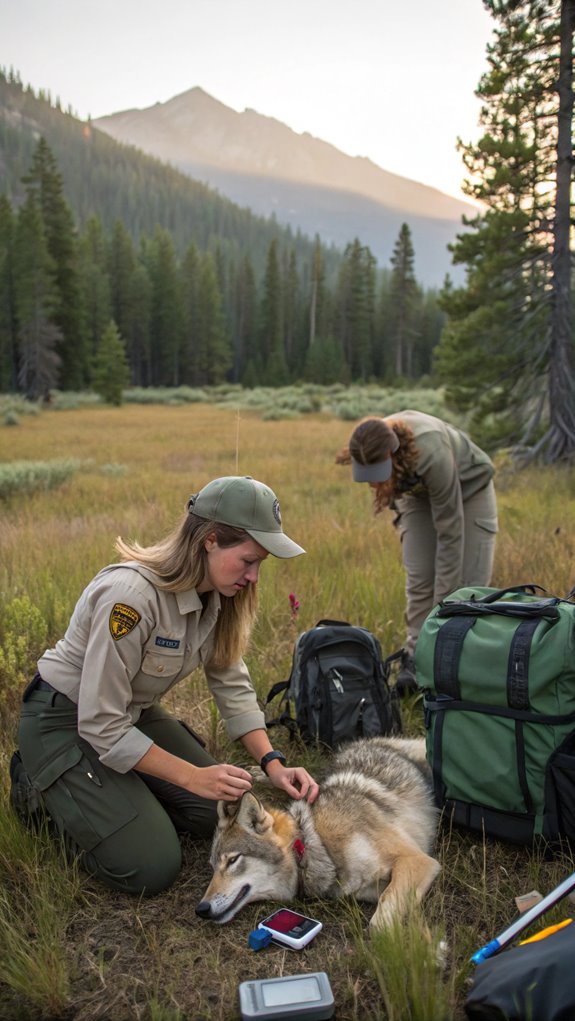
Graduate research and field opportunities form the backbone of wildlife biology programs, offering you hands-on experience in real-world conservation settings. You’ll focus on critical areas like habitat evaluation, wildlife management, and animal damage control, while gaining expertise in studying both game and nongame species. Urban wildlife studies and research on ecosystem alterations will prepare you for today’s diverse conservation challenges. Research topics are carefully aligned with faculty expertise to ensure optimal guidance and resources.
In the field, you’ll collect and analyze data at various research stations and field sites, implementing biological investigations and habitat improvement projects. These hands-on experiences are essential for developing practical skills you’ll need in your future career. You’ll learn to design studies, gather samples, and translate your findings into meaningful conservation actions.
You’ll work closely with faculty advisers and committee members who’ll guide your research journey. The program connects you with external stakeholders in habitat restoration projects, allowing you to build valuable professional relationships. By joining organizations like The Wildlife Society and American Fisheries Society, you’ll expand your professional network and stay current with industry developments.
The program offers specialization options in conservation biology, fish systematics, and fisheries management. You’ll develop leadership and public speaking skills through internships and externships, preparing you for roles in wildlife management and conservation agencies. Access to state-of-the-art laboratories and regular seminars enhances your learning experience. Whether you’re planning to pursue an MS, PhD, or enter the workforce, these research opportunities will equip you with the expertise needed for species restoration and conservation efforts.
Financial Support and Scholarships
Securing financial support for your wildlife biology graduate studies opens numerous pathways through university funding, external grants, and specialized scholarships. You’ll find research assistantships at institutions like Utah State University through faculty contracts and grants, while Oregon State University offers competitive fellowships like the Munson Wildlife Graduate Scholarship and the David B. and Georgia Leupold Marshall Wildlife Scholarship. Programs like the Ashton Award provide up to $4,000 for graduate research focused on Asian tropical forest biology.
For international students, particularly those from developing countries, several organizations provide targeted funding. The African Graduate Student Research Fund from the American Society of Mammalogists supports African citizens, while Zoo New England partners with the Wildlife Conservation Network to assist conservation leaders from low-income countries. The European Union’s EMJMD Scholarship and the Rufford Small Grants specifically support early-career conservationists from developing nations.
You can also tap into research-specific grants from renowned institutions. National Geographic offers Early Career Grants and species recovery funding, while the Smithsonian Environmental Research Center provides Predoctoral Fellowships. If you’re focused on specific wildlife areas, you’ll find specialized opportunities like the National Geographic Big Cats Initiative grants or SWOT’s Small Grants for sea turtle research.
Many universities offer departmental funding opportunities specifically for wildlife biology graduate students. You should explore both university-specific options and external funding sources simultaneously. The British Ecological Society’s Research Grants and the Smithsonian Tropical Research Institute’s fellowships can supplement your university funding, providing extensive financial support for your graduate studies.
Career Paths After Graduation
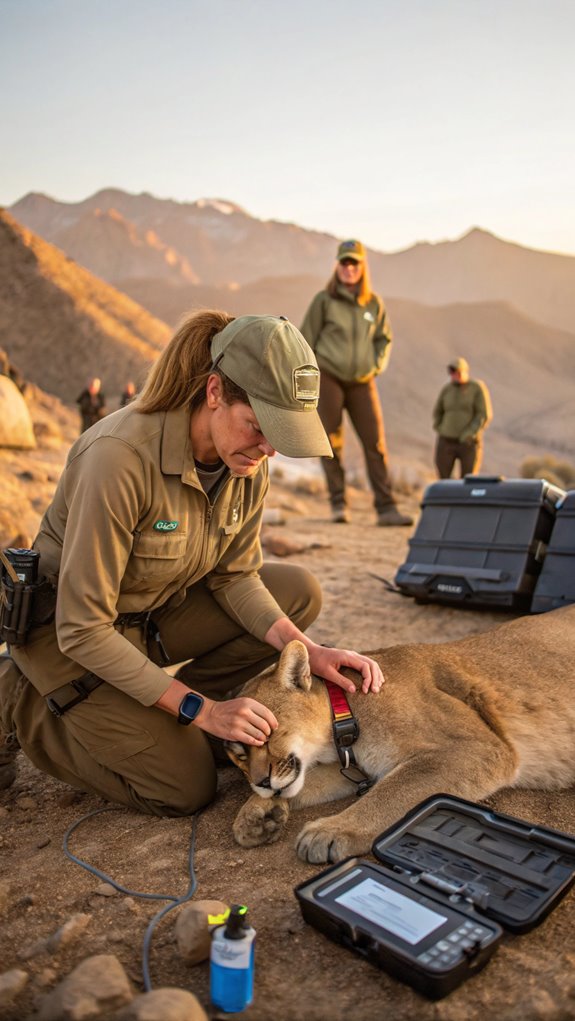
A wide array of career opportunities awaits wildlife biology graduates across government agencies, research institutions, and private organizations. You’ll find positions with federal agencies like the U.S. Fish and Wildlife Service and National Park Service, or you can pursue roles with state-level wildlife departments. Conservation organizations such as Point Blue and SWCA Environmental Consultants regularly seek wildlife biology graduates for various projects and initiatives. The Sacramento region offers excellent employment prospects with higher median wages of $91,830 compared to other areas.
You can specialize in several distinct areas within wildlife biology. As a conservation biologist, you’ll focus on protecting endangered species and their habitats. If you’re interested in law enforcement, becoming a wildlife forensics specialist lets you investigate wildlife crimes. Marine biology offers opportunities to study ocean ecosystems, while restoration ecology allows you to rehabilitate damaged environments.
Your career prospects will improve greatly with advanced education and specialized skills. While a bachelor’s degree qualifies you for entry-level positions, a master’s degree opens doors to senior roles and research opportunities. You’ll want to gain practical experience through internships and volunteer work, and developing technical skills in GIS, biostatistics, and programming will make you more competitive.
The job market for wildlife biologists shows steady growth, with approximately 1,500 openings annually and a median salary of $70,600. You’ll find the most opportunities in regions with national parks, wildlife reserves, and coastal areas. States with extensive public lands, particularly Alaska, offer numerous positions, and you can work in various settings from laboratories to natural habitats.
Required Skills and Prerequisites
Successful admission to wildlife biology graduate programs requires meeting several key prerequisites and demonstrating essential skills. You’ll need a bachelor’s degree from an accredited institution with a minimum 3.0 GPA. Your undergraduate coursework must include biology, chemistry, mathematics (including statistics and calculus), botany, ecology, and evolution.
You’ll need to showcase your research capabilities, including your ability to design research proposals, form hypotheses, and conduct field studies. Strong quantitative analysis skills and familiarity with scientific literature are vital. You must also demonstrate effective written and oral communication skills, as you’ll need to present your findings to both specialized and general audiences.
The application process requires three letters of recommendation, preferably from science faculty or professionals who can speak to your academic and research achievements. Campus tours are available to help prospective students explore facilities and meet potential advisors. You’ll need to submit a research statement if you’re pursuing the thesis track or a statement of purpose for the non-thesis option, along with your resume and transcripts.
Before applying, confirm you’ve identified potential faculty advisors whose research interests align with yours, as most programs require a faculty mentor to agree to work with you. Once admitted, you’ll complete 30 credits of coursework, including core graduate-level courses in biology or wildlife science. You’ll also need to pass thorough written and oral examinations. If you’re on the thesis track, you’ll complete 6-12 credits of thesis work as part of your degree requirements. The program offers various specializations, such as behavioral ecology or wildlife damage management.
Online Learning Options
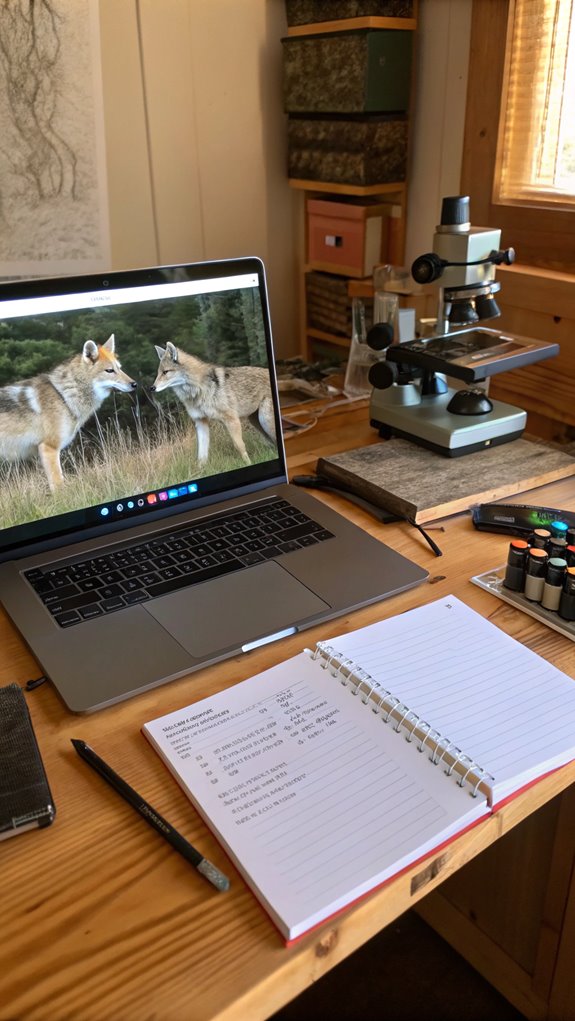
Today’s wildlife biology graduate programs offer flexible online learning options to accommodate working professionals and distant learners. Three prominent universities stand out for their extensive online offerings: the University of Florida, University of Alaska Fairbanks, and Colorado State University. Students in UF’s program must maintain a minimum 3.0 GPA throughout their studies.
You’ll find completely online programs like the University of Florida’s Master of Science in Wildlife Forensic Sciences and Conservation, which lets you study at your own pace. If you prefer a blend of online and in-person learning, the University of Alaska Fairbanks offers a hybrid master’s program that combines both formats. Colorado State University’s asynchronous program in Fish, Wildlife, and Conservation Biology allows you to maintain your professional commitments while advancing your education.
These programs deliver specialized curricula through learning management systems like Canvas. You can focus on areas such as wildlife conservation, rehabilitation, or field biology. At UAF, you’ll study population interactions and physiological ecology, while CSU emphasizes wildlife ecology, management, and policy communication. UF’s program covers unique aspects like crime scene processing and conservation medicine.
You’ll learn from experienced faculty who bring real-world expertise to your online classroom. UAF’s internationally recognized scholars study environmental adaptation and human-wildlife interactions, while CSU’s instructors incorporate their fieldwork experience into your coursework. These accredited programs typically take two years to complete and prepare you for careers in wildlife research, conservation, and natural resource management. Some programs even provide access to field stations and research opportunities, ensuring you get practical experience despite the online format.
Professional Development Resources
Professional wildlife biologists rely on several key organizations for career growth and certification opportunities. The Wildlife Society (TWS) offers two main certification programs: the Professional Development Certificate and the Certified Wildlife Biologist designation. You’ll need to complete specific contact hours through various activities and submit an application with a $25 fee for the Professional Development Certificate. TWS requires that event agendas be submitted at least two weeks in advance for CEU approval consideration.
To maintain your certifications, you’ll need to fulfill continuing education requirements. The Certified Wildlife Biologist renewal requires 80 contact hours in Category I, while the Professional Development Certificate requires 150 contact hours. You can earn these hours through TWS-approved events, including their annual conference, workshops, and technical sessions.
You’ll find numerous training opportunities through TWS local Sections, Chapters, and Working Groups. The Society for Conservation Biology (SCB) also provides worldwide training workshops and courses, with member discounts available. If you’re an early-career scientist, you can take advantage of SCB’s student resources, awards, and fellowships, including the David H. Smith Conservation Research Fellowship Program for postdoctoral support.
For networking and mentoring, you can use SCB’s Job Board and Expertise Database to connect with professionals in your specialty area. Organizations and agencies can get their events approved for continuing education units (CEUs) by submitting agendas to TWS. Universities like Ball State and the University of Alaska Fairbanks offer additional research projects and field experiences to enhance your professional development.

Erzsebet Frey (Eli Frey) is an ecologist and online entrepreneur with a Master of Science in Ecology from the University of Belgrade. Originally from Serbia, she has lived in Sri Lanka since 2017. Eli has worked internationally in countries like Oman, Brazil, Germany, and Sri Lanka. In 2018, she expanded into SEO and blogging, completing courses from UC Davis and Edinburgh. Eli has founded multiple websites focused on biology, ecology, environmental science, sustainable and simple living, and outdoor activities. She enjoys creating nature and simple living videos on YouTube and participates in speleology, diving, and hiking.
🌿 Explore the Wild Side!
Discover eBooks, guides, templates and stylish wildlife-themed T-shirts, notebooks, scrunchies, bandanas, and tote bags. Perfect for nature lovers and wildlife enthusiasts!
Visit My Shop →
